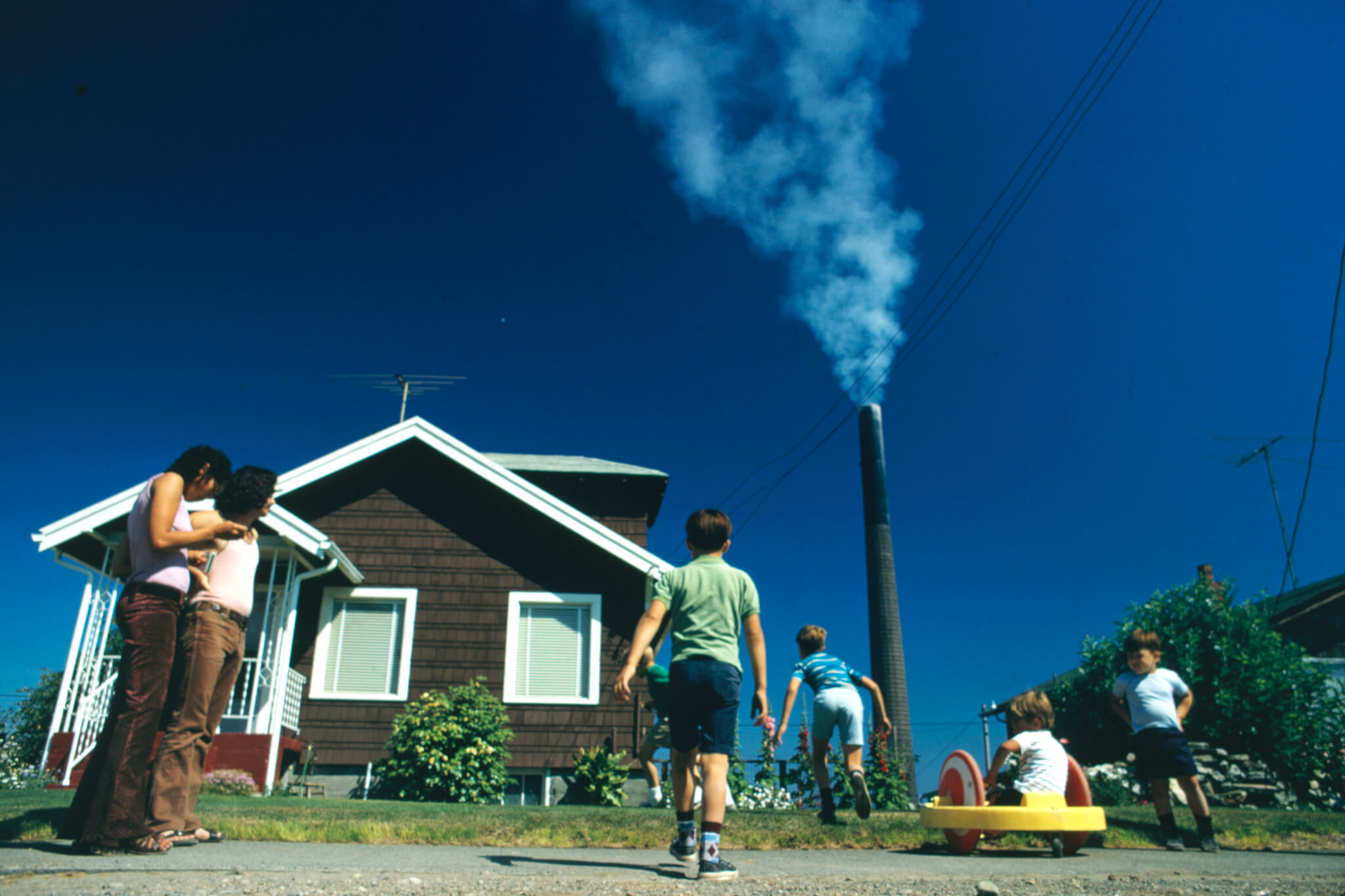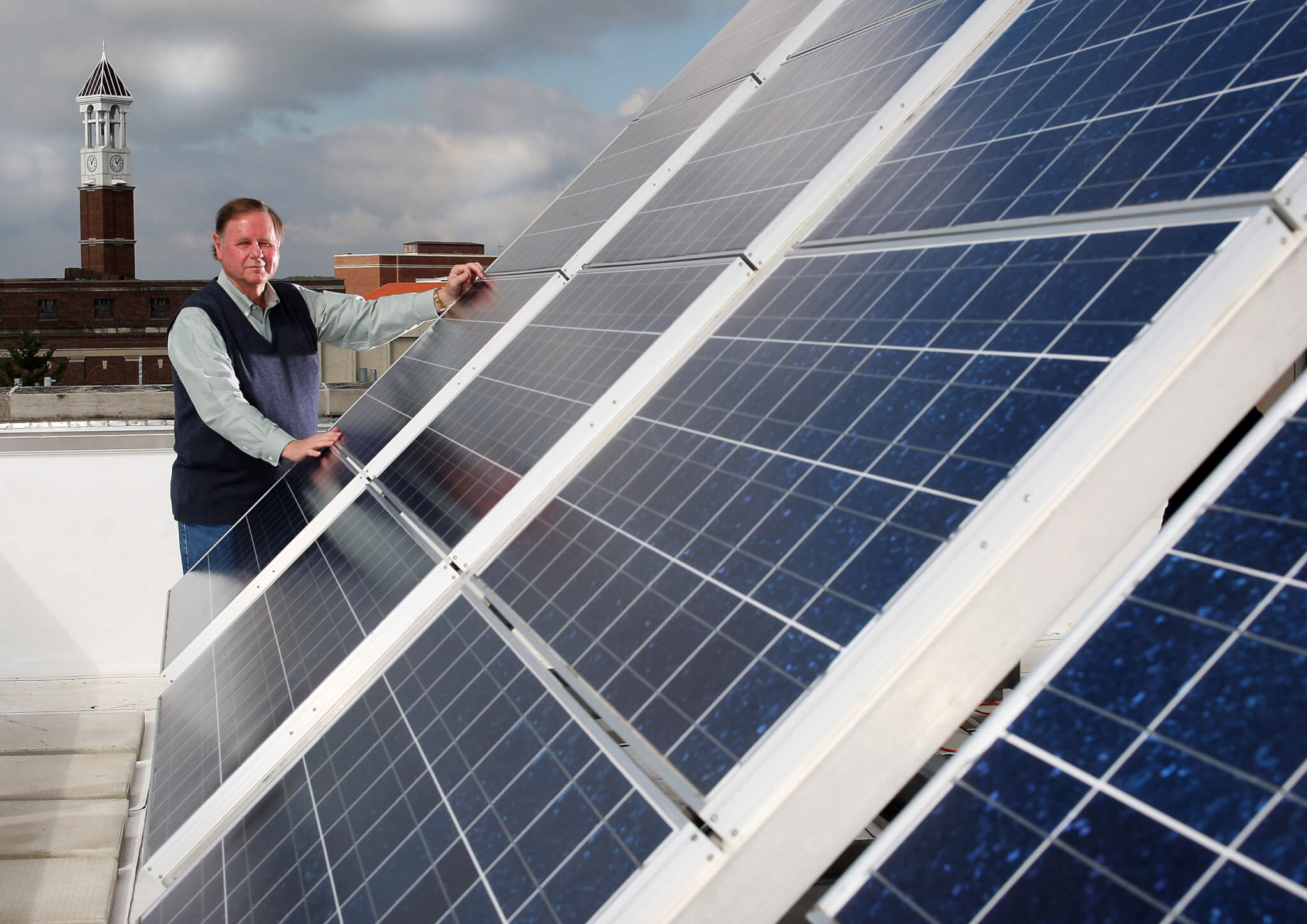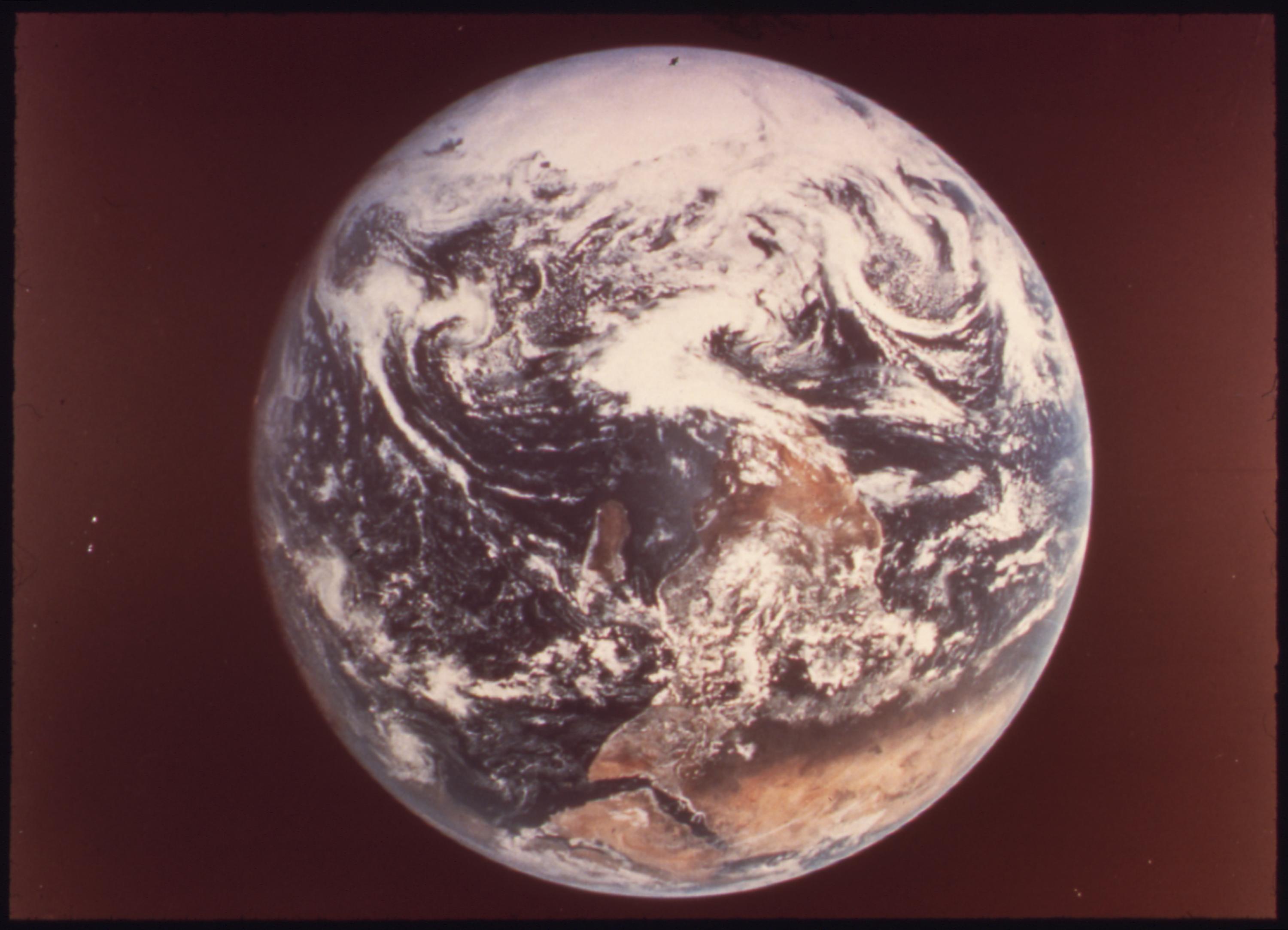A Look at Sustainability Challenges Past, Present, and Future
Editor’s Note: In January 2015, Purdue Convocations presented ETHEL’s Documerica, a boundary-free string quartet that performed a multimedia feast of panoramic projections and newly commissioned works from contemporary American composers. The performance incorporated images captured during EPA’s Project Documerica photo documentary of some 20,000 images from the 1970s. The following paper was written by a panel of Purdue experts who also participated in a discussion of current climatological and environmental issues during ETHEL’s engagement at Loeb Playhouse. We are posting this to wrap up our Documerica performance and to celebrate Purdue’s Green Week — a celebration of campus sustainability efforts that takes place every autumn.
In January 1972 the newly created Environmental Protection Agency launched a photo documentary project, Documerica, to record the state of the environment across America. The project was modeled after the Department of Agriculture’s effort in the 1930s to document rural America during the Dust Bowl and the Great Depression. Called “The Photography Project,“ this earlier effort was led by Roy Stryker through the Farm Security Administration (FSA). From 1935 to 1944 photographers and writers were hired to “relate people to the land and visa-versa.” Stryker’s vision for the project was to “introduce America to America,” in particular, to “show the city people what it’s like to live on the farm.” These FSA photographs became the face of the Great Depression for many in America and were instrumental in galvanizing public support for conservation and assistance programs for rural America.
The EPA had similar hope for Project Documerica —that the images would further energize the fledgling environmental movement, “documenting change so future generations will understand our successes and our failures,” while also recording, “what we do as individuals and as institutions.” By 1978, Documerica photographers had captured 20,000 images chronicling nearly a decade of social and environmental conditions. The photos documented both overtly environmental problems of water, air, and noise pollution, as well as issues related to crumbling cities, suburban sprawl, poverty, energy crises, youth culture, and other challenges of modern life across America.

Images from from the Farm Security Administration’s Photography Project, 1935-1944.
In partnership with the university’s performing arts organization, Purdue Convocations, faculty from Purdue Institute for a Sustainable Futureparticipated in a program in which each selected two photographs from the Documerica archive and used them to consider how environmental, economic, and social challenges have changed from when these photos were taken to the present. This report summarizes those comparisons and offers some ideas about how GSI faculty are working to sustainably manage our global environment for a healthy future in the next 40 years.
THE ACHIEVEMENTS OF THE PAST 40 YEARS
Air Pollution

“Children play in yard of Ruston home, while Tacoma smelter stack showers area with arsenic and lead residue.” Gene Daniels, Ruston, Washington, August 1972.
In 1971, air pollution was a serious problem for most of the nation. Previous efforts to regulate air pollution had been fragmented and largely ineffective until the passage of the Clean Air Act of 1970. By requiring the EPA to set acceptable concentrations of six major air pollutants, the Clean Air Act (and related laws) dramatically improved the air that Americans breathe. At the same time, some of the problems suggested by this photo continue. More than one third of Americans still live in “non-attainment” areas—regions where concentrations of at least one pollutant are above limits considered to be healthy by the EPA. In some cases, poor or minority communities face greater exposure to these pollutants—a problem referred to as environmental justice. In addition, efforts to improve local air quality conditions in the 1970s led to the creation of taller smokestacks that created new long-range pollution problems, where emissions from one region travel hundreds of miles before returning to earth and creating new environmental hazards in other states or nations. Meanwhile, many other air pollutants have increased since 1970, including emissions of CO2 and other greenhouse gases responsible for global climate change, as well as thousands of new compounds facing only limited pre-market toxicity testing under laws such as the Toxic Substances Control Act of 1976.
Water Pollution

“Weyerhauser paper mills and Reynolds Metal Plant are both located in Longview, Washington, on the Columbia River.” David Falconer, April 1973.
The use of rivers as a disposal outlet for sewage and industrial chemicals developed along with the industrial revolution; as America grew, industry released tons of toxic waste materials directly into the nation’s waters. Water pollution was often coupled with open air discharges of gaseous waste, as shown in this Documerica photo of a paper mill plant. Growing public outrage over the dumping of pollution into our waterways and an increasing awareness of the impacts of this pollution on river and stream function prompted Congress to act, and in 1972, the Clean Water Act was passed. Forty years later, the state of our waters has improved but many waterways still fail to meet the law’s standards for swimming and fishing. While factories are now regulated under the Clean Water Act, they can still discharge directly into water, and accidents and bad actors are commonly encountered. So-called “non-point source” pollution, from farm fields and paved urban areas, remains a significant challenge. In addition, large parts of the nation still use combined sewer systems—infrastructure designed to collect domestic sewage, rainwater runoff, and industrial wastewater in the same pipe, like the pictured outfall into the Potomac River near the now infamous Watergate building complex.

“The Georgetown Gap, through which raw sewage flows into the Potomac. Watergate Complex in the rear.” John Neubauer, April 1973.
During major rain events these systems often overflow and release untreated water into rivers, streams, or other nearby surface waters. Some 700 communities and 40 million people live with this engineering legacy (first introduced in 1855) that must be retrofitted and repaired at a great cost.
Public Engagement

“Cyclist in front of environmental center.” Thomas Sennett, Humbolt County, California, May 1972.
In this regard, it is important to also recognize that ordinary people like the ones pictured in this photo were instrumental in creating the environmental improvements that started in 1970. At this time, a public facing the terrible effects of decades of pollution demanded action through protest and public engagement culminating in the first Earth Day on April 22, 1970. This public movement forced government to respond by creating the many environmental laws that remain the heart of environmental protection in the country today: the Clean Air Act of 1970, The Clean Water Act of 1972, the Endangered Species Act of 1973, the National Environmental Policy Act of 1970, etc. Today, grassroots support for environmental protection remains vital, but has also diversified. The movement now includes professional environmental advocacy groups working primarily in Washington, D.C., and in state capitals, as well as an increasingly diverse array of local groups representing a wide range of local community concerns including environmental justice issues.
Energy Production and Use

“Gas station attendants peer over their “Out of Gas” sign in Portland, on the day before the State’s requested Saturday closure of gasoline stations.” David Falconer, November 1973
In this photo we see two gas station attendants in Portland, one day before the State of Oregon stopped gas stations from opening on Saturdays. Why “Sorry, no gasoline”? In 1973, the OPEC oil embargo, combined with declining U.S. oil production, weak national energy policies, and increasing U.S. consumption caused the price of a barrel of oil to skyrocket. But higher oil prices didn’t just put a brake on our driving. The knock-on effect of rising oil prices was to also cause coal prices to rise—an ironic consequence of the Clean Air Act of 1970 was that electric utility companies were shifting from buying coal to buying oil because the oil contained less pollution-causing sulfur compounds. Brownouts and blackouts were commonplace as utilities struggled to meet demand. During the energy crises of the 1970s we learned that energy security underpins our economy, and we learned that outsourcing even a small proportion of our energy supply made us vulnerable to geopolitical strife.

“‘Turn off the damn lights’ stick- ers mirrored the seriousness of the energy situation in Oregon during the fall of 1973. This sticker, in a Portland business office, was used in newspaper ads as well as on television, bill- boards, and car bumpers.” David Falconer, Portland, Oregon, October 1973.
In the second image, an office worker’s briefcase shouts for attention as the need for energy conservation impacted workplaces and homes: “Please, turn off the damn lights!” Forty years later, how have we done? The shale gas revolution has dramatically increased domestic production of oil and gas. The Indianapolis airport has a huge array of solar cells at its entrance. Landscapes across the country are studded with tall and graceful wind turbines. Our cars get more miles per gallon and some of them can run on biofuel or electricity. Creative policies are dedicating funds into effective programs promoting energy conservation and efficiency, and energy consumption per unit of GDP is down ~50%. At the same time, 85% of the total U.S. energy supply is still comprised of fossil fuels. We have an economy fueled by carbon, and we will need to wean ourselves away from fossil fuels if we are to achieve economic, national and climate security.
Agriculture

“Fertilizing in the Imperial Valley.” Charles O’Rear, Blythe, May 1972.
In 1973, the U.S. Secretary of Agriculture famously encouraged farmers to plant commodity crops like corn “fencerow to fencerow,” and strongly supported a transition to industrial agriculture. This Charles O’Rear photograph illustrates the rise of huge single-crop farms, their growing reliance on mechanization to “deep plow” agricultural fields, and the massive use of synthetic fertilizers and pesticides to increase yields (also illustrated in another O’Rear photo, “Crop duster”).

“Crop duster in the Imperial Valley.” Charles O’Rear, Blythe, May 1972.
Although agricultural intensification resulted in record-breaking crop yields, it also caused rapid erosion of America’s fertile topsoil and the transport of unspent nitrogen and phosphorus fertilizers as well as new pesticides into streams, rivers, and groundwater—disrupting aquatic ecosystems and creating conditions harmful to human health. The transition by American farmers from deep plowing to conservation tillage, a practice that leaves a protective crop residue on the soil surface, relied heavily on the design of selective herbicides to control weeds rather than physical cultivation. The 1970s-1980s saw the development of new herbicides, such as atrazine, to control broadleaf weeds in corn fields, and metalochlor to control grass weeds in soybean fields. By 2001 these two herbicides were among the most commonly detected pesticides contaminating drinking water in the U.S. Glyphosate (“Roundup”), also developed during this era was not crop selective—it killed all plants equally—but was less toxic and more readily degraded in the environment. The discovery that genetically engineering a bacterial gene into corn and soybean to render the plants uniquely resistant to this broad-spectrum herbicide brought another sea-change in herbicide use when “Roundup-ready” soybeans were introduced widely in 1994 as the first major genetically modified crop. The widespread use of new herbicides has created new threats, however, including a growing number of glyphosate-resistant “superweeds.” Those pursuing sustainable agriculture today continue to seek new solutions to these ongoing problems including stacking of multiple types of herbicide resistance, introducing new cropping and tillage techniques, and capturing more of the natural genetic diversity of the crop species to improve yields and nutritional quality without artificial genetic modification.
The challenges of the next 40 years
Reviewing the Documerica photos illustrates substantial progress in lessening some of the obvious environmental problems that marked the 1970s in the United States—smoggy cities, rivers running with industrial waste, and rapid soil erosion from agriculture. Many of these accomplishments were made possible by important cross-disciplinary collaborations between scientists and engineers, technological and policy innovations, and a growing understanding of the state and functioning of the environment. Today, the nature and scope of challenges associated with environmental protection, and how we respond to these challenges, are changing rapidly—with global implications. After nearly two decades of research we now have a basic understanding of how human actions are changing the global environment and how these changes will affect human health and well-being.
Unfortunately, the science tells us that we are still on an unsustainable path. Global environmental changes including climate change, biodiversity loss, stresses on the water cycle, soil degradation, and air pollution, are tightly linked to social and economic development. If left unchecked, these changes will significantly affect our ability to meet the basic needs of safe and adequate food, water, energy, housing, and essential ecosystem services for future generations. A sustainable future will require the development of pragmatic ways in which societies can become more effective stewards of Earth’s natural resources while achieving economic and social prosperity. In short, we now face so-called “third generation” environmental problems: global in scale, long-term in scope, plagued by scientific uncertainty, and therefore even more challenging politically. Underlying these problems are the increasingly interconnected, physical, chemical, biotic, and human processes that alter and shape our environment in complex, multifaceted ways over multiple spatial and time scales.
These global realities make it clear that, going forward, we need to encourage discovery and innovation of all kinds to respond to these third generation environmental problems in order to show additional improvement over the next 40 years. Working in coordination with the Global Sustainability Institute, research teams at Purdue are working on important examples of these interconnected challenges with cross-departmental, interdisciplinary approaches.
Protecting the Earth’s critical zone
In a collaboration among five Big Ten universities, Purdue researchers are focusing their attention on understanding and stabilizing the critical zone of intensively managed agricultural and urban landscapes. The critical zone is the region from the treetops to the bedrock aquifers, including the Midwest’s layer of rich topsoil, where the atmosphere, biosphere, and geosphere interact to sustain life. By understanding how natural processes happen together, how they co-evolve, and how human modification has altered them, the project aims to assess the short- and long-term resilience of crucial ecosystem services like freshwater quality and quantity, nutrient cycling and storage, and provision for food, fiber, and other materials. The research will help us understand important questions such as: how much time do we have left before an ecosystem can no longer provide these and other essential services; how can we stabilize the critical zone; and what new science and engineering tools can we develop to monitor and potentially return the system to a healthier state?
Transitioning to more sustainable energy systems
Another grand challenge is to transition from fossil carbon to sustainable carbon at scale while retaining and expanding the versatility and diversity of materials that the petrochemical industry has enabled. Working on this challenge, Purdue researchers are focused on developing new capabilities to predict, design, and control the chemistries of carbon so that we can transition from fossil-based to sustainable bio-based fuels and materials, such as lignocellulosic biomass. They have successfully transformed the main components of biomass (cellulose, xylan, and lignin) from grasses and trees directly to liquid hydrocarbons and aromatic co-products. Moving ahead, this project envisions a future in which chemicals, polymers, plastics and composites – the materials of everyday modern life – are made from plants in production pathways that have net-zero carbon emissions.

The use of solar energy, an emissions-free and inexhaustible resource, is expanding as new policies encourage the adoption of renewable energy sources. In this photo, Purdue University professor and energy economics expert, Wally Tyner, stands amid solar panels on the roof of Purdue’s Knoy Hall. Tyner recently published work on the cost-efficiency of solar energy for Indiana homes in the journal Energy Policy.
With the increasing worldwide demand for renewable energy in mind, Purdue is working to accelerate the development of solar electric technologies by lowering the cost per watt of photovoltaics (PV) and concentrated solar power. Their work reaches beyond the U.S. to rural communities in India, Colombia and Brazil. In Brazil, for example, a collaboration between the Kayapó, an indigenous community in the Brazilian Amazon, and social scientists and engineers from the Federal University of Uberlandia in Brazil and Purdue, is helping to develop culturally-relevant solar energy options in a Kayapó village. A reliable, sustainable energy resource will help the Kayapó community create and maintain a digital media center from which to advocate for conservation measures, showcase sustainable development programs highlighting indigenous ways of knowing, and create new spaces for political authority.
Adapting to global environmental change
Climate change presents individual farmers and supporting institutions with new challenges. Adapting to these challenges requires institutions to gather location-specific climate data, assure its quality and usefulness, and deliver the information in useable ways to those who need it. A Purdue-led project team is combining climate data and models with information on stakeholder beliefs and concerns about climate change and their willingness to use climate information. They have created an effective framework for connecting the scientific community with producers, crop advisors, state and federal agencies, and other agricultural stakeholders to work together on understanding vulnerabilities, creating adaptation strategies, and building resilience to climate change—an approach that can be replicated in other sectors.
Global environmental change is also increasing the risks to diverse human and ecological communities from natural disasters. By studying several small towns in southern Indiana hit by deadly tornadoes in March 2-3, 2012, a group of Purdue researchers will attempt to understand the rate and degree of recovery in each town based on a combination of social and physical factors including social capital, social norms, and variations in physical infrastructure in each community. The goal of the project, which is part of a larger group of related efforts at Purdue, is to develop policy recommendations based on systems analyses that consider the interdependence of communities’ physical infrastructure with their social networks, ultimately enabling citizens and other key stakeholders to rebuild stronger post disaster communities, enhance community resilience, and reduce economic losses in disasters.
Addressing emerging environmental contaminants
Chlorinated volatile organic compounds (CVOCs), a class of chemical pollutants associated with a growing number of US Superfund sites, are known carcinogens, and more recently have been implicated as developmental toxins. CVOCs are common ingredients in a growing list of products including paints, adhesives, dry cleaning solutions, pesticides, cosmetics, and pharmaceuticals. In addition, they are broadly applied as cleaners, degreasers, and reagents in industrial processes. At sites around the country, these chemicals are found to contaminate groundwater at concentrations that are orders of magnitude above the maximum concentration limits for drinking water set by the U.S. EPA. Integrating developmental biology, tissue engineering, nanotechnology and micro-fabrication, toxicology, and environmental sciences with novel engagement strategies, Purdue is leading an effort to better understand how CVOCs impact fetal development so that better public health decisions can be made regarding the assessment and management of risk related to exposure of these compounds.
Each year, the world produces over 50 million tons of electronic waste. Many consumer electronics contain hazardous materials that are harmful to human health and the environment if not disposed of carefully, especially during incineration or landfilling, and even during the recycling process. These products often contain complex mixtures of heavy metals like lead, mercury, and cadmium and other toxins such as polyvinyl chlorides and brominated flame retardants. In addition, many products use a range of rare earth metals and other materials that create tremendous environmental damage during their extraction. Purdue researchers are working on multiple aspects of this challenge. Using an interdisciplinary, life-cycle approach to understanding the problem of environmental contamination from electronics the team is trying to identify less hazardous materials and product designs and make end-of-product-life recycling and disposal safer and easier. The team is also working to understand the factors driving the currently unsafe practices for recycling used electronics in places like China, India, and Africa in order to encourage improved political and social arrangements for dealing with “e-waste.”
Conclusion
It is important to celebrate the many environmental improvements over the last forty years. Many of the problems captured by the Documerica project have improved, and new technologies and policies along with changing behaviors are responsible. At the same time, the world faces continued sustainability challenges looking forward. GSI researchers are striving to help make the improvements over the next few decades even more impressive and integrated than those we have witnessed from 1970 to the present.
Leigh Raymond, Professor of Political Science and Director of the Center for the Environment; Maureen McCann, Professor of Biological Sciences and Director of the Energy Center; Nicholas Carpita, Professor of Botany and Plant Pathology; Ron Turco, Professor of Agronomy and Director of the Global Sustainability Institute; Otto Doering, Professor of Agricultural Economics; and Rose Filley, Managing Director, Center for the Environment and Purdue Climate Change Research Center.
DOCUMERICA Favorites on Flickr
For the Documerica Project (1971-1977), the Environmental Protection Agency (EPA) hired freelance photographers to capture images relating to environmental problems, EPA activities, and everyday life in the 1970s.
The U.S. National Archives digitized more than 15,000 photographs from the series Documerica (Local ID 412-DA) and included them in the online catalog. The site has quick catalog search links for featured DOCUMERICA topics, locations, and photographers.
